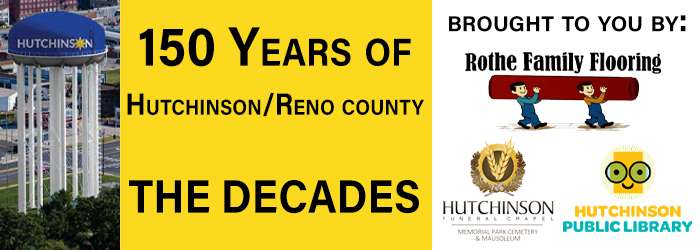
As we celebrate the 150th birthday of Hutchinson and Reno County, we want to go through the years, decade by decade, to see how things have changed and — remarkably — how they have stayed the same. This would not be possible without the efforts of Steve Harmon, the Reno County Museum, and the Hutchinson Public Library, who have made a great effort to supply us with the information and photos that you’ll see in this 15-part series. We hope you enjoy it.
The city of Hutchinson was founded in 1871 when frontiersman Clinton "C.C." Hutchinson contracted with the Santa Fe Railway to make a town at the railroad's crossing over the Arkansas River. The town actually sprang up about one-half mile north, on the banks of Cow Creek, where a few houses already existed.
1871: JHD Rozan and Luther Dodge established the first two settlements in Reno County. The first school was also established and the first herd of cattle came up the western leg of the Chisholm Trail.
1872: The first city election was held. Taylor Fitch was elected mayor with 71 of the 88 votes cast. The city council was made up of Ed Wilcox, D.M. Lewis, R.P. Baily, G.A Brazee and John McMurray. Their first order of business was to adopt the city seal.

1873: The first wheat was planted in the area. The post office was established in what would become the town of Nickerson. Huntsville, Castleton, and Reno Center all popped up as communities. Reno Center is now known as Partridge.
1874: George Shears started a contracting business in the city. Russian Mennonites arrived by train and settled into an area northeast of Hutchinson. The area would become the town of Buhler. The first bridge over the Arkansas River, which was started three years earlier, was finished. The first municipal band was started.

1875: Hutchinson was known for its clean living and effort to open a saloon and end prohibition in the city was challenged often. In 1875, the first request to open a saloon was denied by the city council. The population of Reno County topped 5,000. It was also the first year of the Reno County Fair and the first flour mill opened. It was also the year the first drug store opened in the city.

1876: In what has been a staple of the area for so many years, the First Bank opened its doors. It would become known as the First National Bank. The first YMCA was established and the city became the center for wheat shipping and trading as crop numbers increased. The Water and Power on Mill Race was constructed. The building is now the Stevens Building and is the oldest standing building in the city today.

1877: The year saw the first of two major floods along Cow Creek. Water was in the streets for two weeks. Following the flood, the city council approved bonds to help build a series of flood-control levees. The population of Reno County continued to climb quickly as the population grew to more than 8,000. The city of Arlington was also founded in 1877.

1878: Voters approve to keep prohibition in place in a close vote — 1,006 vote yes and 932 vote no. Winter wheat tops $1.20 a bushel and the town of Plevna is established after a trading post is turned into a post office. In an odd event, a newspaper editor was taken by Topeka authorities for a libel complaint. Area residents set off after the Shawnee Co. authorities in a railroad hand car and caught them in what is now known as Burrton. They got their editor back and the lawmen were arrested in Hutchinson.

1879: As the decade closed out, Nickerson became an incorporated city. The population of Hutchinson continued to grow to 1,740 and the Board of Trade was established. A business school was also established, which became known as the Salt City Business School.
Check back next Sunday for the second part of this series.
The Decades are brought to you by:
Hutchinson Funeral Chapel
Rothe Family Flooring
Hutchinson Public Library
CLICK HERE to download the Hutch Post mobile app.
CLICK HERE to sign up for the daily Hutch Post email news update.





